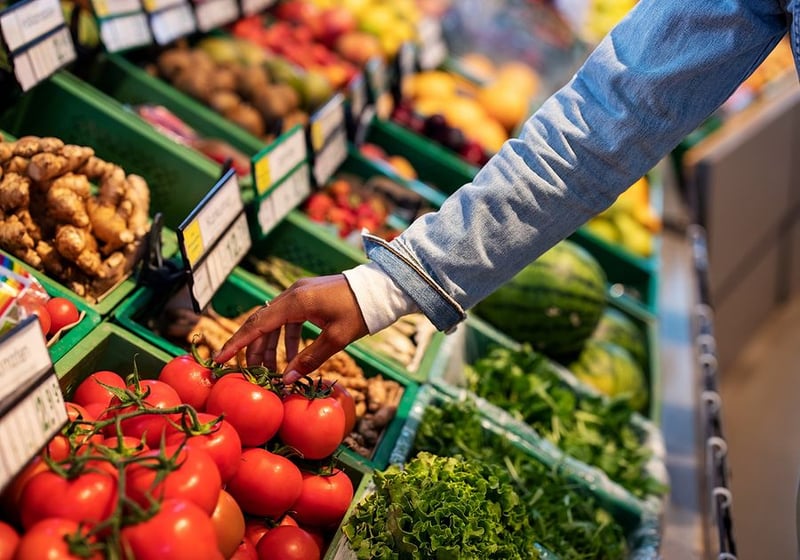
Do you find yourself buying a container of greens every week only to discover that they are slimy and wilted halfway through the week?
Do you pull out your container of berries midweek, excited for a sweet, juicy, snack only to realize they are moldy and need to go in the trash?
Throwing food away is always disappointing, and with grocery prices on the rise, it can be even more stressful. This feeds the idea that eating healthy is too expensive, and something only certain people can afford to do.
However, a few simple shifts in your shopping and storage can help you waste less and get more bang for your buck.
As a registered dietitian, I want to help make healthy eating attainable for everyone. I want to meet you where you’re at, and that means with your budget in mind. Using these hacks can help you eat more fresh food, waste less, and save money.
In this article we’ll break down some of our top tips to help you:
- Set yourself up for success
- Store food smarter
- Prep like a pro
Top Tips To Make Your Food Last Longer
Set Yourself Up For Success
Fridge First
If your fridge isn’t set up properly, your food won’t last as long.
The first thing to check is the temperature. Your fridge should be set between 38 and 40 degrees Fahrenheit for optimal freshness. If you don’t have a temperature gauge in your fridge, you can purchase a small refrigerator thermometer to double-check.
Where you place things matters, too. The interior of the fridge is the coldest part so store milk, dairy, meat, and other more perishable items on the shelves. The doors are the warmest part and should be reserved for condiments, sealed beverages, and other less-perishable items.
Take Inventory
Before your next stock-up, make sure to take inventory of what you already have on hand. Doubling up increases the risk of things going bad before you can use them.
Additionally, checking what you have in the fridge and getting rid of things that have expired or that you know you won’t use is smart on multiple fronts.
First, it keeps things simple and allows you to see what you have on hand. Second, having a less full fridge allows for better circulation, which helps preserve the fresh food you do have in there.
Savvy Shopping
Being smart about what you buy is really the beginning of it all.
Shopping specifically for what you need over the next few days or weeks will allow you to purposefully buy food that you are likely to consume and avoid overbuying.
Be realistic here, if you’re not going to make yourself salads this week, don’t buy the container of greens, just because you feel like you should!
Savvy shopping also includes looking at the dates on the items you buy. Check the expiration and/or best-by dates to ensure you are able to use each item before it has expired. You can always look for items with later dates. Oftentimes these will be stocked behind the items that expire first.
Store Your Food Smarter
Leafy Greens
We’ve already talked about greens going bad, but luckily there is a way to prevent this.
To soak up the moisture that causes your greens to break down, place a paper towel or small reusable towel, directly into the container of greens after opening it. This will keep them from turning slimy and sad.
Herbs
If you love buying fresh herbs, but hate how quickly they spoil, try storing them like a bouquet of flowers.
Stand your herbs up in a small glass or jar filled with water to keep them fresh. You can also loosely place a bag over the top to help preserve them.
Berries
To keep the mold away and extend the life of your berries, start by washing them in a mixture of one-part white vinegar and three parts water when you get them home.
This next step is key. Allow them to fully dry before putting them away.
Store them in a container or reusable bag with a fresh, dry towel or paper towel to continue to control the moisture inside.
Asparagus
If you find your asparagus getting soft and slimy, try storing it just like fresh herbs. Break off the woody stems and stand them upright in a glass or jar with water.
This will help it stay firm until you’re ready to use it.
Avocados
Unfortunately, it seems like avocados have the shortest shelf-life of any produce item.
If you buy avocados that aren’t quite ripe yet, store them on the counter until they are ripe. Transfer the avocados to the fridge when they are ripe to prevent them from getting overripe.
Bananas
Bananas will brown faster when they are separated from each other so keep them attached until you’re ready to eat them. You can also try wrapping the top of the bunch in foil or plastic wrap to keep them fresh a little bit longer.
If your bananas have passed their prime, you can freeze them to use them in smoothies. You can use this trick with berries, and other fruits, too.
Peel the bananas and cut or break them into smaller sections. Spread them out on a baking sheet and freeze them for a few hours to allow them to harden. This prevents them from sticking together. When they are hard on the outside, place them in a sealed bag or container in the freezer.
You can also use this freezer trick for your berries.
Bread
If you find yourself debating whether it’s best to store bread at room temperature or in the fridge, we are here to settle that debate. Keep your bread in a sealed container at room temperature for maximum freshness.
If your bread is nearing the end of its shelf life, place it in a sealed bag or container in the freezer to extend its lifespan.
Nut Milk
Most nut milk has a little note on the container stating they should only be kept for 7-10 days after opening. If you’re not drinking enough nut milk to use the full container that quickly, you may be better off making your own at home.
Machines like the Nutr allow you to make your own plant-based milk at home in less than five minutes. You can also control how much you make so if you only need one cup, you can just make one cup and save yourself from dumping part of a bottle down the drain at the end of the week.
Dry Goods
While we don’t often think of goods like pasta, rice, and flour going bad, these items do all have an expiration date.
To help ensure they stay fresh as long as possible, move any dry goods that are in an open box or bag to a sealed storage container to maximize freshness.
Prep Like A Pro
Let It Cool
Do you put all of your food into containers, pop the lid on, and put them in the fridge while they’re still hot? If you do, you’ve likely noticed the condensation that forms on the inside of the lid. This excess moisture can cause your food to spoil faster.
Instead, allow your food to cool, uncovered, before placing the lid on and sealing it to go into the fridge.
First In, First Out
This may seem simple and self-explanatory, but even if last night’s leftovers were delicious, if there are older leftovers in the fridge, try to use those first.
This method is called first in, first out, and can help you cut down on food waste, simply by using things efficiently.
Another little tip, store leftovers in clear containers at eye level in the fridge so you can clearly see what is there instead of losing things to the back corner or the bottom shelf.
When To Freeze
Most prepared foods and leftovers will last in the fridge for 3-5 days
If you aren’t going to use the food within that timeline, transfer it to the freezer for maximum freshness. When you are ready to use those items, defrost them in the fridge overnight so they are ready for the next day.
You can also prep with the intention of freezing things right away. Souper Cubes makes silicone trays in varying sizes for you to freeze anything from soups and sauces to spaghetti and sweet treats.
What’s Next?
If you’re feeling inspired to put these tips to use, dive into your OnPoint Member Portal for recipes to inspire your next stock-up and put those ingredients to good use.
If you still need some help integrating these tips, talk with your dietitian or nutritionist about how they can work in your life.
If you’re not currently working with a dietitian or nutritionist, we’ve got your back. Here at OnPoint Nutrition, we have helped thousands of people build healthier habits and achieve their nutrition goals.
To speak with someone on our team and get started on your journey, schedule a free consultation today.
Topics

Liz has been reading nutrition labels since she learned how to read. Growing up with severe peanut and tree nut allergies she learned that it’s important to know what you are putting into your body. She made her first big lifestyle change as a freshman in high school, when she decided to become a vegetarian. However, it wasn’t until she took a food class in Italy as part of a study abroad program in college that it clicked in her mind that she wanted to make food and nutrition her career. Liz graduated from Penn State University in 2015 with a bachelor's degree in Nutrition, as well as a bachelor's degree in Marketing. She completed her dietetic internship with Aramark in Philadelphia, and her master's degree at Northeastern University shortly after.




